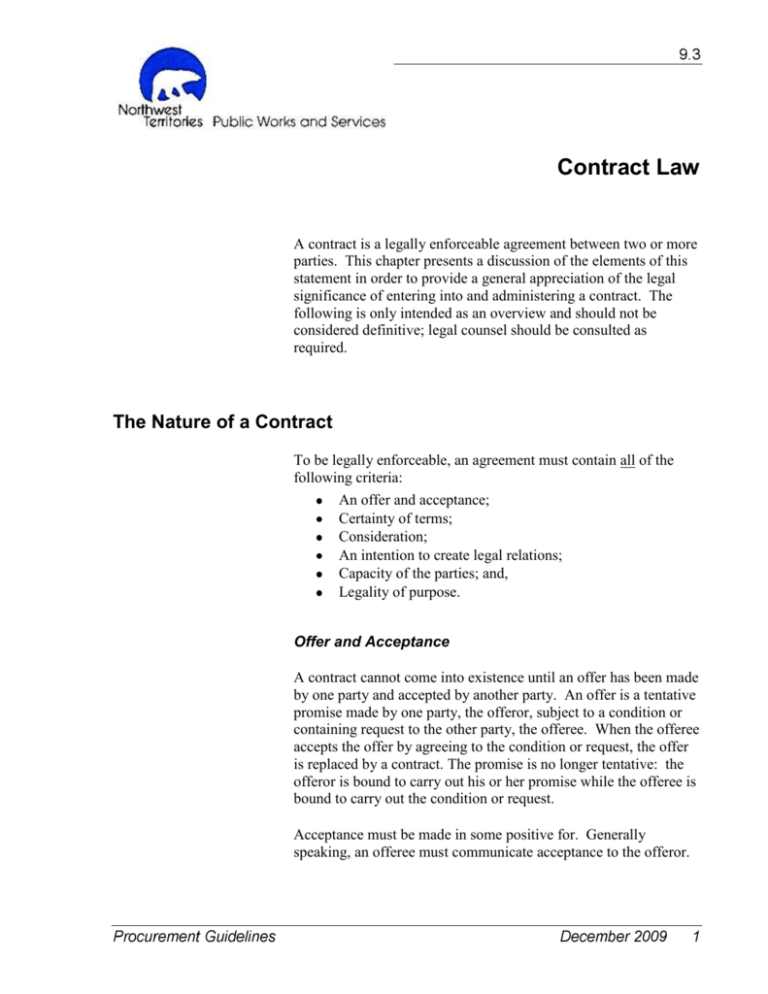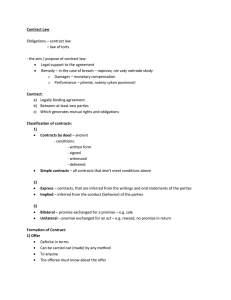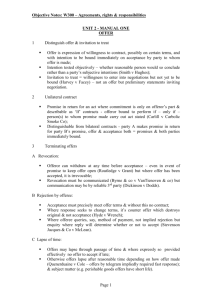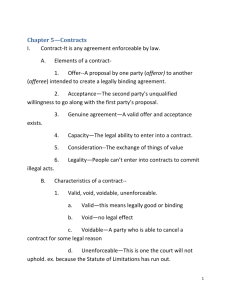Contract Law
advertisement

Contract Law A contract is a legally enforceable agreement between two or more parties. This chapter presents a discussion of the elements of this statement in order to provide a general appreciation of the legal significance of entering into and administering a contract. The following is only intended as an overview and should not be considered definitive; legal counsel should be consulted as required. The Nature of a Contract To be legally enforceable, an agreement must contain all of the following criteria: An offer and acceptance; Certainty of terms; Consideration; An intention to create legal relations; Capacity of the parties; and, Legality of purpose. Offer and Acceptance A contract cannot come into existence until an offer has been made by one party and accepted by another party. An offer is a tentative promise made by one party, the offeror, subject to a condition or containing request to the other party, the offeree. When the offeree accepts the offer by agreeing to the condition or request, the offer is replaced by a contract. The promise is no longer tentative: the offeror is bound to carry out his or her promise while the offeree is bound to carry out the condition or request. Acceptance must be made in some positive for. Generally speaking, an offeree must communicate acceptance to the offeror. The moment that a contract is formed by offer and acceptance, each party is bound to its terms. Certainty of Terms The formation of a contract depends on a meeting of the minds or consensus as to thee terms of the proposed contract. Both parties must have a clear understanding of their rights and duties in the transaction for there to be consensus. Consensus requires that the terms of the proposed contract be reasonably specific or, alternatively, be reasonably ascertainable by means of an agreed formula or principle of determination. An agreement to agree on certain terms later on is not a contract. Certainty of terms is the essence of a contractual agreement. It should be noted that terms of a contract are the documentation to understanding. As that understanding evolves or changes, it is important to keep the document current with the understanding by amending it as appropriate. In this way, a contractual document can be viewed as the baseline for contract performance which can be adjusted and modified as required during the contract to reflect changes in circumstances as they arise. Consideration At the root of the idea of a contract is the concept of a bargain, that one party must pay a price – that is, make some, contribution – for the promise he or she obtains from the other party. For the most part, consideration is essential to make a contract binding in law. An Intent to Create Legal Relations An Agreement must be deliberate, or seriously intended, to be enforceable, so that it is understood that in the event of a breach of obligation, the parties could enforce the contract through the courts. In business transactions it is presumed that the parties do intend the agreement to have legal consequences. In the government context, however, many documents are signed which are not intended to create legal relationships such a Memoranda of Understanding. These understandings are typically between various elements of the executive, such as two departments. Capacity of Parties An otherwise valid contract may be defeated by the lack of contractual capacity of one of the contracting parties. The law presumes that each party to the contract has the legal capacity to enter into it. The GNWT is a legal entity and contracts through it employees, each of whose authority or capacity to bind the GNWT may be limited in some fashion. The legal capacity of the GNWT in the sense of its powers under a contract arise by reason of statutory law. Legality of Purpose The object of the contract must be “legal”. Business transactions must neither offend the public good nor violate the law. If they do, the contract will deemed to be “void”, which means that in law it was never formed. Laws of Tenders The Law of Tenders in Canada stipulates that invitation of tenders, the submission of tenders and the receipt of bids creates a binding contract “A” between the tender originator and every bidder so long as the bid is not withdrawn prior to tender closing. The contract ultimately entered into between the tender originator and the successful bidder is referred











